'An indictment of South Africa': whites-only town Orania is booming

Twenty-five years after apartheid, black people cannot live and work in this small South African city
Photographs by Madelene Cronjé
by Dennis Webster in Orania
Thu 24 Oct 2019 10.17 EDT Last modified on Thu 24 Oct 2019 11.03 EDT
October in Orania can be charming. When the sun sets, long ribbons of burnt orange settle on the horizon. The flies and mosquitoes that come with the summer’s oppressive heat haven’t arrived yet. It is Magdalene Kleynhans’ favourite time of year. “You can sit outside until late into the night,” says the businesswoman, whose family spends much of their time outdoors. Her children fish from the banks of the Orange River whenever they choose. Kleynhans leaves the house unlocked. “It’s a good life. It’s a big privilege.”
But there is much more to small Northern Cape town than the bucolic ideal painted by Kleynhans. Incredibly, 25 years after the fall of apartheid, Orania is a place for white people only.
Orania represents downright hostility to the idea of a single, united, non-racial country
Tembeka Ngcukaitobi, author
Kleynhans runs one of Orania’s biggest enterprises: a call centre whose business is recruiting and retaining members for Solidariteit, a trade union primarily for Afrikaner workers, and Afriforum, a self-styled “civil rights” movement. Afriforum recently met with US president Donald Trump’s administration and Tucker Carlson of Fox Nows to tell them that Afrikaners are facing a widely discredited genocide. Both have made extensive investments in Orania’s construction boom.
Oranians claim the town is a cultural project, not a racial one. Only Afrikaners are allowed to live and work there to preserve Afrikaner culture, the argument goes.

The town has faced numerous calls for it to be broken up over the years, with prominent author and advocate Tembeka Ngcukaitobi arguing its existence violates South Africa’s successful dismantling of racial segregation. “Orania,” he says, “represents downright hostility to the idea of a single, united, non-racial country.”
Large-scale eviction
Orania was created in 1991, a year after Nelson Mandela’s release from Robben Island, and three years before the country’s first democratic election.
Set among lush pecan nut orchards in the otherwise arid Karoo, it was set-up as an Afrikaner-only hamlet, not dissimilar from the ethnic Bantustans established under former prime minister, Hendrik Verwoerd, often dubbed the “architect of apartheid”.

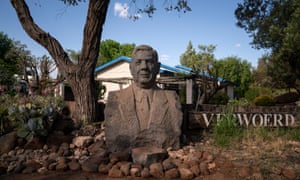

By the end of the 1980s, the probability of losing control had already occurred to many Afrikaners, with some believing that impending democracy posed an existential threat to the white Afrikaans way of life. A few felt protecting that required becoming a demographic majority somewhere, rather than remaining a minority everywhere.
So a small group of Afrikaners – Verwoerd’s daughter and son-in-law, Carel Boshoff, among them – purchased a strip of land on the southern banks of the Orange River, and went about setting up a volkstaat, or independent homeland, where Afrikaners would decide their own affairs.
Orania’s founders did not settle on virgin territory, but on the remains of a half-realised 1960s project to build canals and dams along the Orange River. A community of 500 poor black and mixed-race squatters who had made their homes in the buildings left behind by the project stood between the new owners and their whites-only vision.
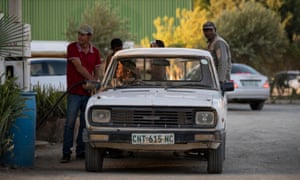
The population has doubled
After three decades as a quiet backwater, Orania is booming. Its population – currently around 1,700 – has doubled over the last seven years. The most recent census estimates growth of more than 10% a year, outstripping most comparable rural towns and more, proportionally, than South Africa’s biggest cities.
Population growth means a flourishing housing market and construction industry. Neat suburban homes have been joined by new apartment blocks and walkups which sell for as much as R1.5 million (£80,000), putting them on par with comparable homes in Johannesburg. There is an industrial zone of brick and aluminium factories which sell their products around South Africa. China buys most of the pecan nuts.
They will hurt you. There is nothing we can do
Benjamin Khumalo,
The growth shows no signs of slowing. A sewage works meant to accommodate 10,000 future residents is in the pipeline. There are designs to transform the town’s humble technical training facility – where many of the skills driving the town’s new construction were taught – into a university.
Not a single brick has been laid by a black worker. In a reverse of the usual situation in South Africa, all low-paying work in Orania – from keeping the town’s gardens to packing the shelves in its grocery stores – is performed by hard-up white Afrikaners. It is increasing numbers of poor labourers, whose tenancy is often less secure and who either rent or rely on subsidies from Orania’s cooperative bank, who are largely behind the town’s growing population.
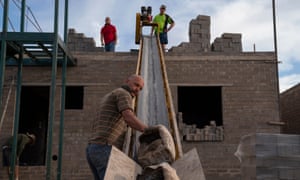
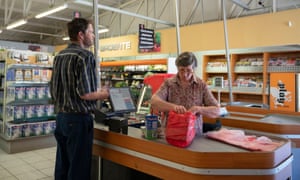
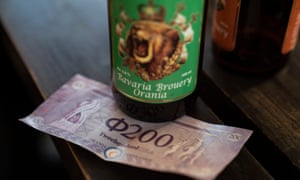
People who want to live in Orania buy shares in the Vluytjeskraal Aandeleblok, instead of freehold. The screening of prospective shareholders allows for tight control. Buyers undergo extensive vetting, central to which is their fidelity to Afrikaans language and culture, a commitment to employing only white Afrikaners, and a string of conservative Christian undertakings. Unmarried couples, for instance, cannot live together.
The town exists at the mercy of the South African constitution. In the early 2000s, a planned remapping of boundaries that would have brought Orania under the control of a democratically elected municipality appeared to spell the end, but the town successfully appealed to the high court using the constitutional rights of the country’s minority cultural groups.

Twenty-five years after apartheid, black people cannot live and work in this small South African city
Photographs by Madelene Cronjé
by Dennis Webster in Orania
Thu 24 Oct 2019 10.17 EDT Last modified on Thu 24 Oct 2019 11.03 EDT
October in Orania can be charming. When the sun sets, long ribbons of burnt orange settle on the horizon. The flies and mosquitoes that come with the summer’s oppressive heat haven’t arrived yet. It is Magdalene Kleynhans’ favourite time of year. “You can sit outside until late into the night,” says the businesswoman, whose family spends much of their time outdoors. Her children fish from the banks of the Orange River whenever they choose. Kleynhans leaves the house unlocked. “It’s a good life. It’s a big privilege.”
But there is much more to small Northern Cape town than the bucolic ideal painted by Kleynhans. Incredibly, 25 years after the fall of apartheid, Orania is a place for white people only.
Orania represents downright hostility to the idea of a single, united, non-racial country
Tembeka Ngcukaitobi, author
Kleynhans runs one of Orania’s biggest enterprises: a call centre whose business is recruiting and retaining members for Solidariteit, a trade union primarily for Afrikaner workers, and Afriforum, a self-styled “civil rights” movement. Afriforum recently met with US president Donald Trump’s administration and Tucker Carlson of Fox Nows to tell them that Afrikaners are facing a widely discredited genocide. Both have made extensive investments in Orania’s construction boom.
Oranians claim the town is a cultural project, not a racial one. Only Afrikaners are allowed to live and work there to preserve Afrikaner culture, the argument goes.

- Magdalene Kleynhans owns a call centre that employs around 55 people in Orania
The town has faced numerous calls for it to be broken up over the years, with prominent author and advocate Tembeka Ngcukaitobi arguing its existence violates South Africa’s successful dismantling of racial segregation. “Orania,” he says, “represents downright hostility to the idea of a single, united, non-racial country.”
Large-scale eviction
Orania was created in 1991, a year after Nelson Mandela’s release from Robben Island, and three years before the country’s first democratic election.
Set among lush pecan nut orchards in the otherwise arid Karoo, it was set-up as an Afrikaner-only hamlet, not dissimilar from the ethnic Bantustans established under former prime minister, Hendrik Verwoerd, often dubbed the “architect of apartheid”.

- Busts of former presidents of the town surround the statue of town mascot De Kleine Reus (The Little Giant), a young boy rolling up his sleeves, intended to symbolise the Oranians’ belief in self reliance


By the end of the 1980s, the probability of losing control had already occurred to many Afrikaners, with some believing that impending democracy posed an existential threat to the white Afrikaans way of life. A few felt protecting that required becoming a demographic majority somewhere, rather than remaining a minority everywhere.
So a small group of Afrikaners – Verwoerd’s daughter and son-in-law, Carel Boshoff, among them – purchased a strip of land on the southern banks of the Orange River, and went about setting up a volkstaat, or independent homeland, where Afrikaners would decide their own affairs.
Orania’s founders did not settle on virgin territory, but on the remains of a half-realised 1960s project to build canals and dams along the Orange River. A community of 500 poor black and mixed-race squatters who had made their homes in the buildings left behind by the project stood between the new owners and their whites-only vision.

- Black people are restricted to using the petrol station on the edge of Orania
The population has doubled
After three decades as a quiet backwater, Orania is booming. Its population – currently around 1,700 – has doubled over the last seven years. The most recent census estimates growth of more than 10% a year, outstripping most comparable rural towns and more, proportionally, than South Africa’s biggest cities.
Population growth means a flourishing housing market and construction industry. Neat suburban homes have been joined by new apartment blocks and walkups which sell for as much as R1.5 million (£80,000), putting them on par with comparable homes in Johannesburg. There is an industrial zone of brick and aluminium factories which sell their products around South Africa. China buys most of the pecan nuts.
They will hurt you. There is nothing we can do
Benjamin Khumalo,
The growth shows no signs of slowing. A sewage works meant to accommodate 10,000 future residents is in the pipeline. There are designs to transform the town’s humble technical training facility – where many of the skills driving the town’s new construction were taught – into a university.
Not a single brick has been laid by a black worker. In a reverse of the usual situation in South Africa, all low-paying work in Orania – from keeping the town’s gardens to packing the shelves in its grocery stores – is performed by hard-up white Afrikaners. It is increasing numbers of poor labourers, whose tenancy is often less secure and who either rent or rely on subsidies from Orania’s cooperative bank, who are largely behind the town’s growing population.



- All low-paying work in Orania is performed by hard-up white Afrikaners. The town also has its own currency, the ‘Ora’.
People who want to live in Orania buy shares in the Vluytjeskraal Aandeleblok, instead of freehold. The screening of prospective shareholders allows for tight control. Buyers undergo extensive vetting, central to which is their fidelity to Afrikaans language and culture, a commitment to employing only white Afrikaners, and a string of conservative Christian undertakings. Unmarried couples, for instance, cannot live together.
The town exists at the mercy of the South African constitution. In the early 2000s, a planned remapping of boundaries that would have brought Orania under the control of a democratically elected municipality appeared to spell the end, but the town successfully appealed to the high court using the constitutional rights of the country’s minority cultural groups.
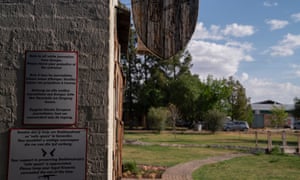
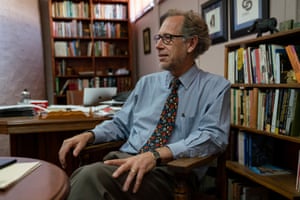


 SA airforce needs to carpet bomb these pale b*stards into oblivion
SA airforce needs to carpet bomb these pale b*stards into oblivion

 Good job
Good job